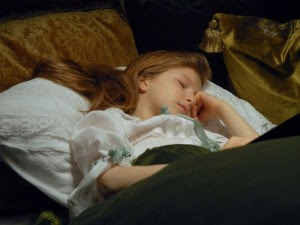 It is axiomatic that fairy tales morph with each re-telling. This narrative shape-shifting lets each new version capture new anxieties, reflect new eras; each new author adds his or her own personal stamp. Catherine Breillat’s Sleeping Beauty is no exception. As the director said in a recent interview, “When I made the film I had to ask, ‘Why me?’ I have to become part of the story. I have to be it.” With Sleeping Beauty, Breillat re-imagines the plot by starting from the most seemingly obvious point: the heroine’s dreams. (After all, what else can you do with a character whose main action is sleeping?) Breillat imagines a girl who “wanted to be daring and do things that were dangerous, forbidding, and do them in her own way.” So the passive protagonist of yore becomes an adventurer, whose soul fearlessly roams the universe as her body lies asleep in a silent chamber. Or, as Breillat puts it, this is no “a little Barbie pink dream.” This decision is both brilliantly simple and dazzlingly inspired. Whether the film always holds up to this conception is a matter of debate, but as a guiding construct it is nearly perfect.
It is axiomatic that fairy tales morph with each re-telling. This narrative shape-shifting lets each new version capture new anxieties, reflect new eras; each new author adds his or her own personal stamp. Catherine Breillat’s Sleeping Beauty is no exception. As the director said in a recent interview, “When I made the film I had to ask, ‘Why me?’ I have to become part of the story. I have to be it.” With Sleeping Beauty, Breillat re-imagines the plot by starting from the most seemingly obvious point: the heroine’s dreams. (After all, what else can you do with a character whose main action is sleeping?) Breillat imagines a girl who “wanted to be daring and do things that were dangerous, forbidding, and do them in her own way.” So the passive protagonist of yore becomes an adventurer, whose soul fearlessly roams the universe as her body lies asleep in a silent chamber. Or, as Breillat puts it, this is no “a little Barbie pink dream.” This decision is both brilliantly simple and dazzlingly inspired. Whether the film always holds up to this conception is a matter of debate, but as a guiding construct it is nearly perfect.Want more? The rest of the review is here! Aren't you angry I'm making you click something?
No comments:
Post a Comment